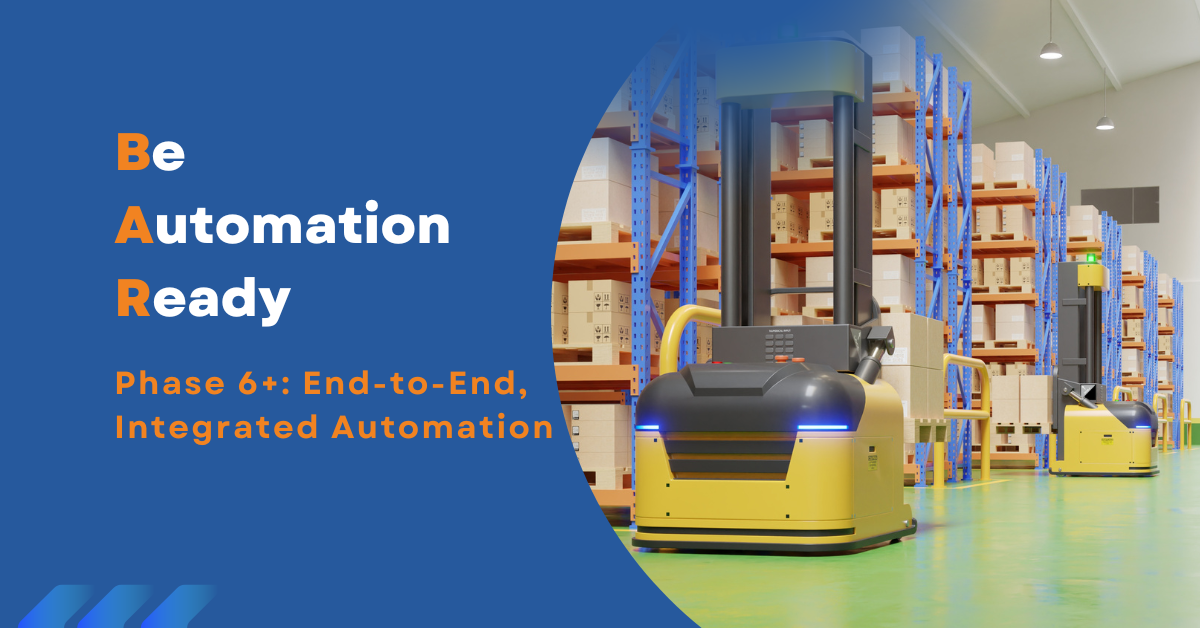


Welcome to the final phase of the BAR (Be Automation Ready) series. We’ve moved from foundational tasking systems to dynamic, demand-ready fulfillment. Now, we arrive at the future: End-to-End Integrated Automation, where robotics, orchestration and AI converge into a single, synchronized system.
As warehouses adopt more technology, the risk of fragmentation grows. Disconnected software, machines, and teams create data silos that hamper visibility and performance. In fact, 82% of enterprises report that these silos disrupt critical workflows, and nearly half of supply chain leaders say siloed systems prevent effective operations.
The solution? Integration powered by orchestration. A Warehouse Execution System (WES) acts as the brain, unifying sub-systems, vendors and workflows into a harmonious whole. The result is faster, more adaptive and error-resistant operations.
Integrated automation combines state-of-the-art robotics, AI-driven decision-making, and orchestration-first logic to enable real-time, autonomous operations. It’s not just about adding more robots — it’s about ensuring that every part of your warehouse works in harmony.
This evolution builds directly on the foundations laid in earlier BAR phases:
Phase 2: Tasking systems now serve as orchestration engines, dynamically assigning tasks across humans, robots and subsystems.
Phase 3: Assisted picking evolves into robot-assisted accuracy, where humans and machines coexist in optimized workflows.
Phase 4: Goods-to-Person (GTP) systems transform into robot-managed inventory, handling replenishment and fulfillment with minimal human touch.
Phase 5: Waveless fulfillment becomes the launchpad for fluid, adaptive, always-on orchestration powered by AI.
Integrated automation transforms warehouses into intelligent ecosystems where robots, AI and human expertise converge to create seamless, self-optimizing operations that adapt in real time to changing demands.
Autonomous Mobile Robots (AMRs), robotic arms, conveyors and humans work as one. Robots take on tasks like picking, packing, sorting and replenishment. This reduces manual effort while boosting speed and precision.
AI algorithms use real-time data to dynamically assign resources, predict demand shifts and continuously optimize workflows. The system learns and improves on its own.
IoT sensors monitor equipment health, enabling predictive alerts before failures happen. This reduces unplanned downtime and keeps operations running smoothly.
Cobots support humans in complex or dexterous tasks, while people oversee strategy, handle exceptions and guide continuous improvement.
Cutting-edge systems are modular, allowing operators to expand, upgrade or reconfigure workflows quickly without massive reinvestments.
Here’s how to move from fragmented operations to fully orchestrated, end-to-end automation in a warehouse that’s intelligent, adaptive and built for scale.
Analyze your automation maturity. Where are the gaps? Which processes are still siloed? What’s your current throughput vs. target?
Choose vendors with proven orchestration platforms, flexible robotics and deep integration experience — not just hardware providers.
Deploy intelligent, interoperable systems that deliver measurable ROI and scale with your business.
Train teams to interpret data, manage exceptions and operate alongside intelligent systems. People remain key to high-performing automation.
Use AI insights to refine workflows, test changes quickly and stay ahead of market and demand shifts.
End-to-end integrated automation doesn’t just streamline operations — it’s about delivering tangible, measurable results. Here’s what businesses can expect when orchestration becomes the norm.
A well-orchestrated warehouse sees up to a 15% boost in throughput and 12% more units processed per hour, thanks to real-time task optimization and smoother handoffs.
WES platforms streamline labor and equipment usage, with some businesses reporting up to an 80% reduction in administrative costs and dramatic drops in travel time per order.
With automated workflows across picking, sorting and replenishment, orchestration combined with automation unlocks greater output per employee without requiring additional headcount.
Integrated systems can dynamically reassign tasks, reroute workflows and scale with demand spikes. This ensures uptime, flexibility and future-ready performance.
Phase 6 is not the final step. It’s where automation continuously evolves from isolated functions to a living, breathing system that thinks, learns and adapts. As fulfillment becomes more complex, orchestration becomes your competitive edge.
Ready for end-to-end integrated automation?
GreyOrange helps enterprises unlock the full potential of their warehouses through orchestration-first design and next-gen robotics from best-in-class vendors. Contact us today to begin building the warehouse of the future.